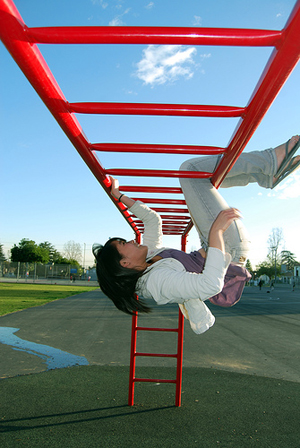
Source: Union High School Library, Utah State Library, Flickr
Asking and answering questions based on the title of a text is one annotation strategy. It helps you locate the main ideas and important details in a reading assignment or test passage. Now watch “Marking the Text.” A teacher demonstrates another process for annotating a newspaper article that will help you expand on the strategy you just learned.
In “Marking the Text,” the teacher suggested these four steps when annotating text:
- Read the title and write a prediction about the content of the article.
- Do a first reading without marking the article in order to get a general idea of the key ideas.
- Number the paragraphs.
- Do a second reading, circling unfamiliar words and underlining the author’s main ideas or claims.

Practice these steps with an article from the New York Times titled “School Recess Improves Behavior” by Tara Pope-Parker. Make a prediction about the article’s content by completing the statement below. Click on the box that you think is correct to record your answer.
Because it appeared in the New York Times and refers to “recess” and “behavior,” I predict that this article will deal with the subject of _____________________________. Hint: What kind of “behavior” might be discussed in the article?
Check the box below that best describes your prediction.
Now that you have made some predictions, read the article “School Recess Improves Behavior.”
School Recess Improves Behavior
By Tara Parker-Pope

Source: Cathy, kakachu, Flickr
Children who misbehave at school are often punished by having to stay inside at recess. But new research shows that giving children recess actually helps solve behavioral problems in class.
Researchers from the Albert Einstein College of Medicine reviewed data on about 11,000 third graders, collected in 2002 as part of the Early Childhood Longitudinal Study, financed by the United States Department of Education to determine how a wide range of family, school, community and individual factors affect a child's school performance.
The study, published this week in the journal Pediatrics, found that about one in three of the children in the group received fewer than 15 minutes of daily recess or none at all. Compared with children who receive regular recess, the children who were cooped up during the school day were more likely to be from public schools in the Northeast or South. They also were more likely to be black, from low-income and less-educated families and live in large cities.
When teachers were asked to rate children’s behavior, the kids who received at least 15 minutes of daily recess scored better than those who didn’t get recess. Dr. Romina M. Barros, a pediatrician and assistant professor at Albert Einstein, said the data were important because many new schools were being built without adequate outdoor space for students. She says it’s a “big mistake” for teachers to punish a child for bad behavior by denying recess.
“We need to understand that kids need a break,” Dr. Barros said. “Our brains can concentrate and pay attention for 45 to 60 minutes, and in kids it’s even less. For them to be able to acquire all the academic skills we want them to learn, they need a break to go out and release the energy and play and be social.”
Schools need to recognize that recess is an essential part of a child's learning experience, Dr. Barros said. At recess, students “use all the things they learned in the classroom. When they are doing hopscotch they use math skills. Kids learn a lot about social skills during recess, such as playing, sharing, being the leader, following somebody. It’s all very important.”
It’s not clear from the data whether teachers also were affected by a lack of recess. It may be that teachers who were stuck in the classroom had less patience and gave children harsher scores for relatively benign behavior than teachers who received recess breaks themselves.
“If the teacher, an adult, is tired of being inside the classroom,” Dr. Barros said, “can you imagine how it must feel to a 7- or 8-year-old?”
Now you’re ready to mark the text. Reread “School Recess Improves Behavior,” but this time, circle unfamiliar words and underline or highlight the claims made in favor of recess. Remember to highlight sparingly, restricting yourself to individual words or brief phrases in favor of recess.
For this part of the activity, download the article “School Recess Improves Behavior.” You can either print this file and use a highlighter and pencil to annotate it or use your software’s highlighting and drawing features if you prefer to do the exercise on-screen. When you are finished, return to this section and check your understanding to see a possible response.
School Recess Improves Behavior
By Tara Parker-Pope

Source: Cathy, kakachu, Flickr
Children who misbehave at school are often punished by having to stay inside at recess. But new research shows that giving children recess actually helps solve behavioral problems in class.
Researchers from the Albert Einstein College of Medicine reviewed data on about 11,000 third graders, collected in 2002 as part of the Early Childhood Longitudinal Study, financed by the United States Department of Education to determine how a wide range of family, school, community and individual factors affect a child's school performance.
The study, published this week in the journal Pediatrics, found that about one in three of the children in the group received fewer than 15 minutes of daily recess or none at all. Compared with children who receive regular recess, the children who were cooped up during the school day were more likely to be from public schools in the Northeast or South. They also were more likely to be black, from low-income and less-educated families and live in large cities.
When teachers were asked to rate children’s behavior, the kids who received at least 15 minutes of daily recess scored better than those who didn’t get recess. Dr. Romina M. Barros, a pediatrician and assistant professor at Albert Einstein, said the data were important because many new schools were being built without adequate outdoor space for students. She says it’s a “big mistake” for teachers to punish a child for bad behavior by denying recess.
“We need to understand that kids need a break,” Dr. Barros said. “Our brains can concentrate and pay attention for 45 to 60 minutes, and in kids it’s even less. For them to be able to acquire all the academic skills we want them to learn, they need a break to go out and release the energy and play and be social.”
Schools need to recognize that recess is an essential part of a child’s learning experience, Dr. Barros said. At recess, students “use all the things they learned in the classroom. When they are doing hopscotch they use math skills. Kids learn a lot about social skills during recess, such as playing, sharing, being the leader, following somebody. It’s all very important.”
It’s not clear from the data whether teachers also were affected by a lack of recess. It may be that teachers who were stuck in the classroom had less patience and gave children harsher scores for relatively benign behavior than teachers who received recess breaks themselves.
“If the teacher, an adult, is tired of being inside the classroom,” Dr. Barros said, “can you imagine how it must feel to a 7- or 8-year-old?”
After completing this exercise, answer the multiple choice questions below to measure your understanding of this article.

- What support is used to back up the claim that recess improves behavior?
- In her defense of recess, the author includes all of the following EXCEPT—